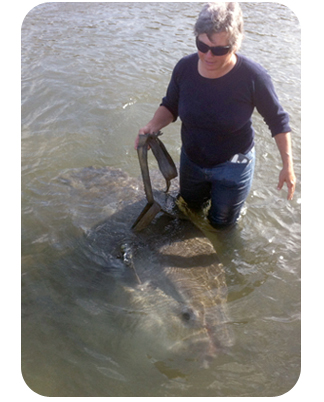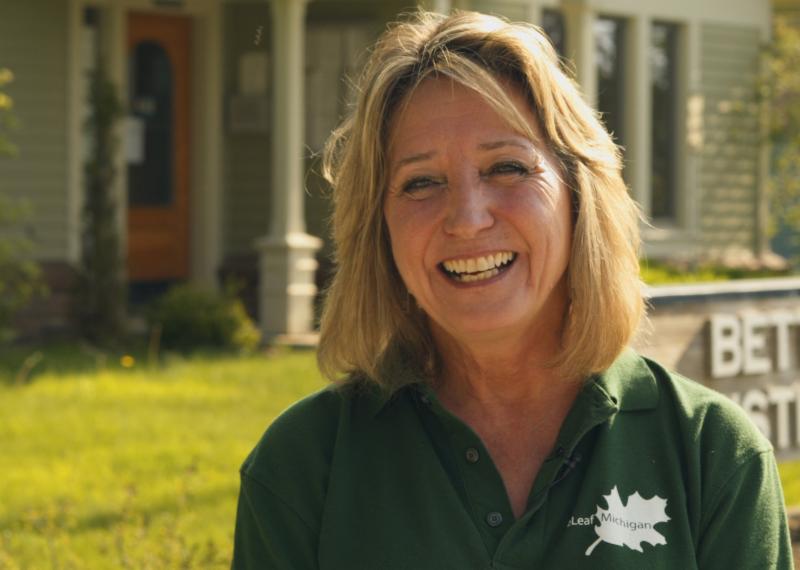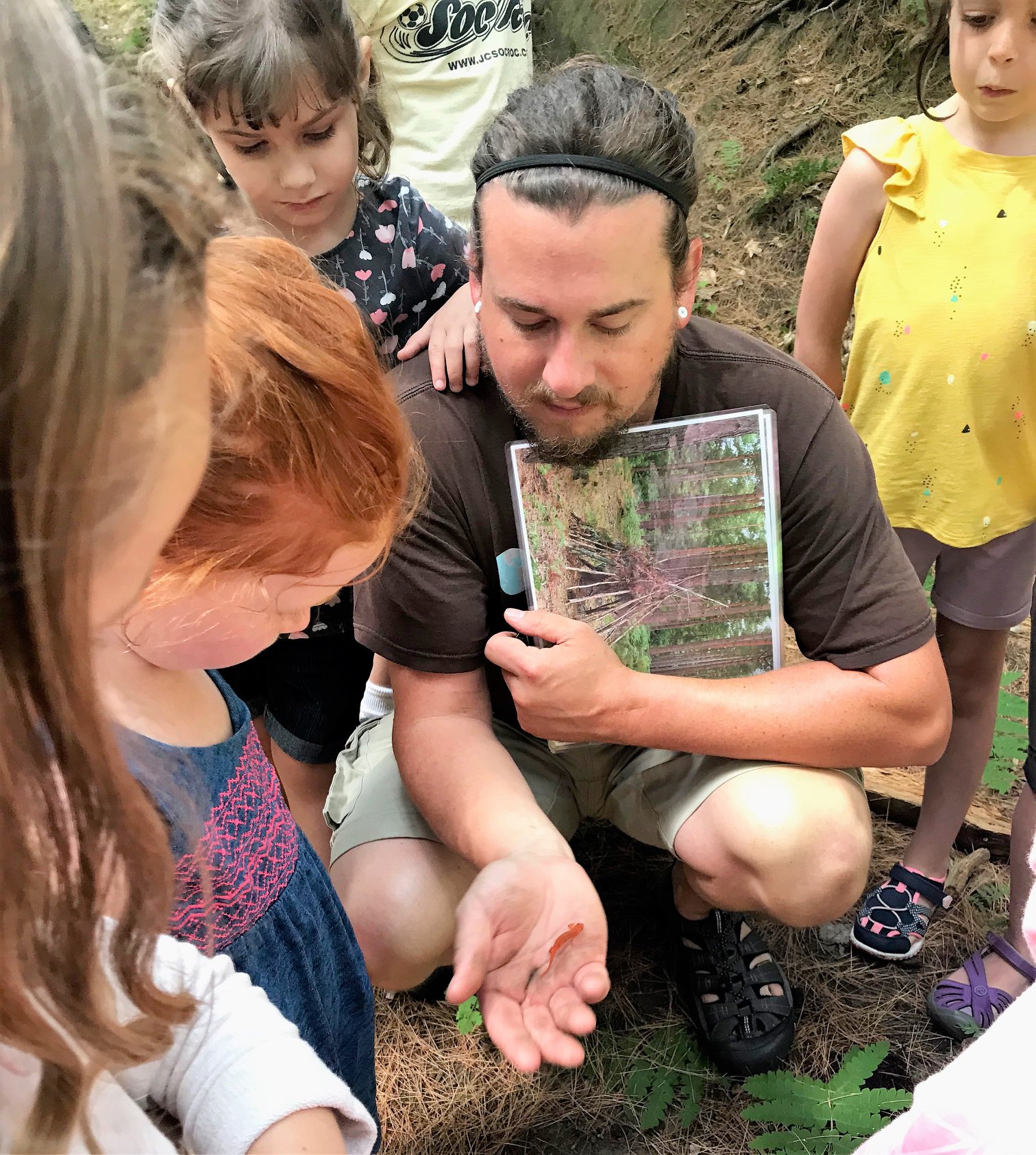Why did you start working with Missouri River Relief? It was the people that enticed me to the organization. Some of my girlfriends and I went to the cleanup and enjoyed it. We met some cool river people, and they convinced me to partake in more cleanups. It was then that I got to know […]
Q&A with TAKO – Lana
What is your favorite part of TAKO? She loves working with all of the families as a family unit. In her professional life she’s either teaching at schools or teaching adults. It’s so much fun to work with different family groupings: 2 grandparents + 2 teenagers, 2 parents + a toddler. Sometimes it’s putting a […]
Q&A with TAKO – Judy
Describe TAKO They’ve been doing events since 2008. Became efficient with their setups. Everything is in boxes/shelves in a trailer. Food is adjustable/modular based on the volume of people they expect. Events are adult and kid oriented, and they are self-guided since they focus on unstructured play. They always have a them, and then people […]
Q&A with Jay DeGregorio
At this point, it’s been about 4.5 years. February of 2017 was when I got hired on as a Nature Museum Environmental Educator.
I was attracted to The Nature Museum because I had some colleagues at the time who had spoken highly about it. It’s just a great small environmental education center, with a sound mission, and has access to fantastic natural areas.. Grafton is beautiful. Plus, I knew The Nature Museum had done work with schools and summer camps, and that work with the youth was something that really made me interested in wanting to be a part of it.
My favorite way to experience nature is through movement and active ways. I think Snowboarding, hiking, and biking. I really just enjoy being immersed in the natural world and having time and space to really connect with the outdoors.
The museum is open year-round. Our hours shift seasonally. At the museum, we have several hands-on exhibits, especially for kids. Bones to look at, puzzles to do, furs to touch. But it’s great for adults too. We have three wonderful dioramas (huge depictions of scenes in nature). We have an awesome observational bee hive that visitors can look right into. We have a mineral cave to look at local minerals, as well as minerals from around the world. It’s a really unique and impressive curation for such a small museum. Importantly, we have great outdoor exhibits and spaces too. We have beautiful garden beds around the museum with a variety of native plants that are ecologically beneficial to wildlife.. We have the gorgeous Chapman Meadow that we manage for pollinators and wildlife where you can find mowed paths winding throughout it. And excitingly, we now have our Magic Forest Nature Playscape. It’s just downright cool! My colleague and Executive Director, Nick, and I worked on that A LOT over this past year. It’s a playground I could have only dreamed of as a kid. There’s a kid sized play cabin, balancing stumps, small suspension bridge, primitive shelter, and nature art loom where kids weave in flowers, sticks, and any other natural item they can find… It’s a long answer, but there’s all kinds of things people can do when they visit.
I wish people knew there’s more than just the museum. I was talking about our gardens, our meadow, and our playscape. These things are all new and improved! We can’t wait for folks to continue to discover them and enjoy them. But, I feel we are situated in a fantastic place where people can enjoy the museum and jump off to explore all kinds of other things to do in the area. Grafton has a lot of great hiking, biking, birding, fishing, etc. within a 15-mile radius of us that we are happy to share those other places and opportunities where folks can engage with nature beyond the museum in our bigger “backyard”. But also, we do a lot of programming/ Although we do a lot of youth programming, we do programming for all ages and some folks don’t know that. Importantly, we always do our best to make programming and visitation both accessible and affordable. We are really looking forward to getting back into that more as we are entering into fall.
Yes! Nick actually saw a gray fox, about a month ago. I found this tree where owls commonly sit, and I regularly find owl pellets. We’ve seen and heard red fox all throughout the year. All kinds of raptors can often be seen soaring above the valley in the warm months. Since we’ve managed our meadow we’ve seen Eastern bluebirds and bobolinks come back. Not to mention, insects galore! We actually just did a citizen science event with Vermont Center for Eco Studies, who’s trying to figure out the population of a certain group of insects in Vermont called lady beetles. And, we found a species that, to our knowledge, has never been officially recorded in Grafton, VT before! That was a real technical find, but a really cool find on our part. I’ve also seen moose and bears near The Nature Museum before.
My favorite season is winter. I just love winter. I find it really unique to be outdoors. You can see so much. The signs of wildlife are often more obvious, tracks and other things. Yeah, winter for me by far, I think I just feel more at home during winter.
The Bellows Falls Fish Ladder and Visitor Center in Bellows Falls, Vermont is one of many along the Connecticut River. We work with Great River Hydro, the operating energy company, to provide education to the community and visitors. A fish ladder basically offers an option for migrating and native fish to bypass a dam. There are many different kinds of fish ladders. The Bellows Falls dam is a Vertical Slot Fish Ladder. I would tell kids, its kind of like an accessibility ramp for fish. If you look at the fish ladder, there are switchbacks, and each pool is just a little bit higher than the next, which mimics the rapids that these fish have adapted to travel through countless years before the dams.
We are a small, but mighty, 501c3 non-profit. Donations of any kind, big or small, have a huge impact for us. Our mission is to serve as a regional resource for all things nature and science education to people of all backgrounds. We want to make our programs and the museum accessible. That’s why admission is by donation, we don’t have a set admission price. For many of our programs, we’ve moved towards doing a sliding scale so there’s different options for folks. We’re constantly thinking and evolving to make what we do universally accessible, impactful, and meaningful.
Also, volunteering is huge. For the Fairy House Festival, for many years we’ve needed upwards of 60 volunteers for the whole weekend. That’s important to us. We are always open to any way people can help us at any time of year, even if it’s not money. Maybe it’s donating Fairy House materials, or maybe volunteering another time. Also, just spreading the word about us is incredibly helpful.
Q&A with Nick Katrick
It’s a little different for me vs. the hundreds of other volunteers. I sent the Executive Director a letter in 2008 suggesting the hours at the Wildflower Center (WFC) were the worst for fine art nature photography (9-5). I suggested they grant me 24/7 access to the center and I would give them rights to use all the photographs I take there. They liked the idea and I’ve been going there on average 2x per week since 2008. I usually arrive before sunrise and shoot for 1-2 hours until the wind picks up or it becomes too sunny. I prefer calm, cloudy days for what I do. I shoot images at the WFC for a few hours then come home and post process them for an hour or two. The WFC uses my images for wall art, web, email, publications and banners around the center. They first used my images to hang in the courtyard restrooms so I usually tell people I got my start with restroom art.
Since 2008. It’s a beautiful place and very quiet and peaceful when I’m there. There are hundreds of volunteers that do hard labor to create a wonderful nature experience. I get to take advantage of that so it is a very symbiotic relationship. I’ve taken over 12,000 pictures at the WFC.
Hummm. There are many but if I had to choose one I would say sitting on my stool in the middle of the arboretum looking up at my favorite oak tree with the sun rising behind it. Quiet, peaceful, colorful, inspiring.
I look for anything that is interesting and I try to capture an image that I would want to look at over and over. It might be a tree or an insect or a wildflower, grass, reptile, mammal or interesting shapes or colors while walking around. I might have a general area of the WFC I plan to visit on a particular morning or I just get out of the car and start walking around. I’ve never gone home without taking some interesting images….even in December and January. In the end, I like to take pictures where you look at it and just go, “wow”.
Nikon D800 and D850. My favorite lens is the 200mm macro. I also carry a wide angle, 24-70mm and a 70-210mm. I use a Uni-loc tripod, cable release and I carry a knee pad. I also have small gentle clamps to hold wildflower stems so the wind won’t move them. I do post processing with Adobe Lightroom and Photoshop and I do focus stacking using Zerene Stacker. So, for the type of photography I prefer to do I’m on a tripod 95% of the time and shooting with a cable release, kneeling on a knee pad. Pretty simple.
I enjoy looking closely at nature so I’m drawn to macro photography. I usually shoot in the range 1:1 to 1:4. So macro and close up. I like out of focus backgrounds and tack sharp subjects. That is why I like calm mornings so I can get sharp images and overcast so I get good color saturation and less super high contrast. I don’t shoot people, birds or nudes. Lately, I’m taking more wildflower focus stacks. Shooting at wider apertures and changing the focus plane taking multiple shots of the subject and then combining them in post processing. This technique produces nice soft backgrounds (bokeh) and tack sharp subjects. You control what you want in focus and what you don’t. It helps to eliminate distracting backgrounds so you can highlight the subject better.
When you take a portrait image of a person you like to put them in the best light and try to make them look a little better than they normally do ;). I do the same thing with wildflowers. I try to make them look the best they can. No insect damage, in great light with no distractions in the background. I often try to line them up so there is a similar bloom in the background WAY out of focus behind the bloom I’m focusing on. This puts a similar blurred color behind the bloom making for a more interesting but non-distracting background. You can see that style in many of the images I have taken. Sometimes I bring interesting botanical subjects home and shoot them in a white box at 5x or 10x. Then you really get to see botanical structures you can’t see with your naked eyes. It’s a whole other world when you get really close.
I would say I really don’t have one favorite but my favorite ones are those where I remember the time and place when I took the picture and the picture itself takes me back to that time. I also like the pictures I’ve taken where the view is so close you see things that you normally wouldn’t see with the naked eye or images that tell a story.
I don’t really know. I guess you would call them on the phone and ask how you could get involved. I interact in person with the staff very infrequently as I’m usually leaving when they are arriving. We wave a lot.
*Volunteer opportunities can be found here: https://www.wildflower.org/volunteer/
Featured Photographer: Jess Keller
Wild Boyz Photography is proud to have Jess Keller join us this month as a featured photographer. Jess is a graduate from Indiana University in underwater archeology. She is passionate about protecting the world’s ocean and was able to do that while working for the National Park Service. Currently, Jess works for NOAA and is […]
Featured Photographer: Daniel Acker
I’m honored to be considered for this month’s feature – especially under the black and white theme. I remember working late with my instructor in the darkroom, remarking that I believe black and white photography to be a particularly valid artistic medium. It’s a limited palette with the necessary bones for complete expression. When chasing […]
Q and A with Carol “Krill” Carson
What led you to working with the New England Coastal Wildlife Alliance (NECWA)? We founded NECWA in 2005 to support basking shark and ocean sunfish programs. While whale watching we would see those animals, and people were always so excited to see them. We set up a community sighting network, with the understanding that the […]
Q and A with Melinda Jones
What led to you founding ReLeaf Michigan? I have been a forester/arborist for a long time. I have a degree in forestry and helped to start ReLeaf Michigan in 1988. It was initially called Global ReLeaf of Michigan. A study had found that for every four trees being removed in the state of Michigan, only […]
Featured Photographer: Jay DeGregorio
We’re excited to feature Jay DeGregorio this month as a featured photographer. Jay has a Masters of Science in Environmental Studies with a focus on Environmental Education, from Antioch University New England. He currently works at The Nature Museum in Grafton, Vermont. The Nature Museum provides experiences that engage and enlighten audiences of all ages, while […]






